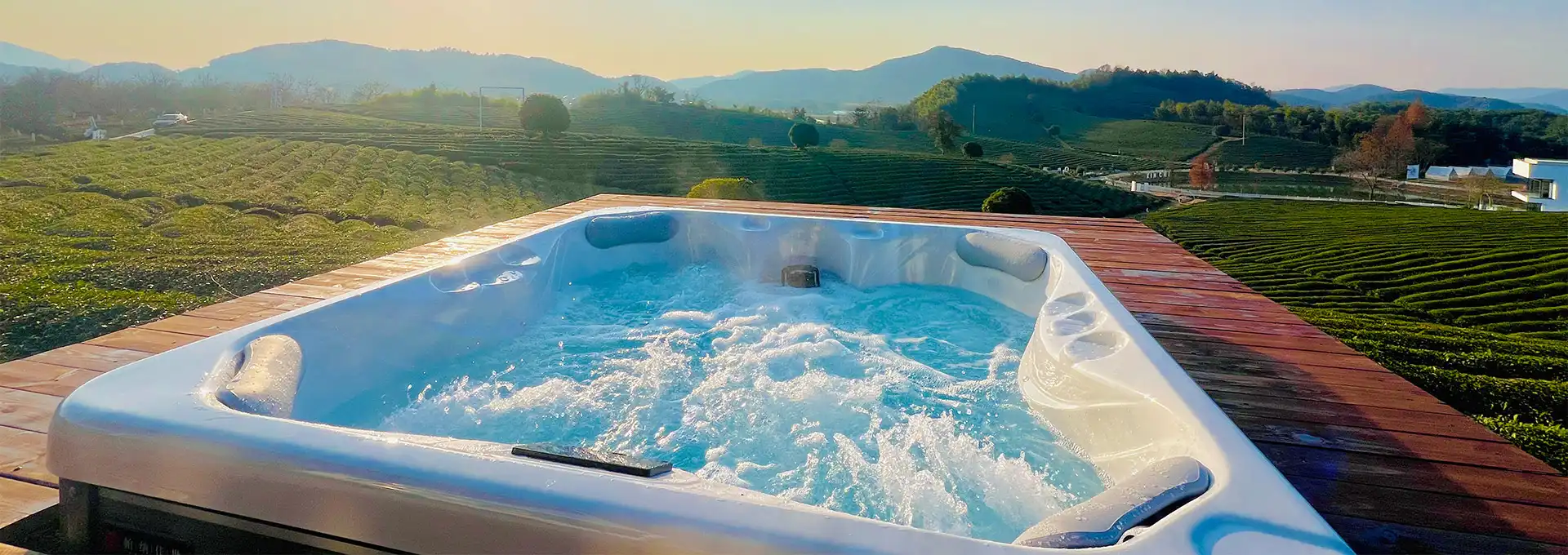Why is My Swim Spa Water Green?
Having a green, murky swim spa can be frustrating and unappealing. The once clear and inviting water has turned into an unsightly shade, leaving you wondering what went wrong and how to fix it. Green water in a backyard swim spa is typically caused by an overgrowth of algae, which thrives in warm, stagnant water with a high level of nutrients. This issue can be exacerbated by factors such as improper water chemistry, inadequate sanitization, and lack of proper circulation. In this comprehensive guide, we'll explore the causes of green water in swim spas, effective solutions to eliminate algae, and preventive measures to maintain crystal-clear water.
What Causes Green Water in a Swim Spa?
The first step in addressing green water is to understand the root cause of the problem. Green algae, a type of microscopic plant life, can quickly proliferate in swim spas when the conditions are favorable. Several factors contribute to this overgrowth:
1. Imbalanced Water Chemistry: Maintaining proper water chemistry is crucial for preventing algae growth. Factors like pH levels, alkalinity, and calcium hardness play a significant role. If these levels are not within the recommended ranges, it creates an environment conducive to algae growth.
2. Insufficient Sanitization: Chlorine or bromine are essential for keeping backyard swim spa water sanitized and free from harmful microorganisms like algae. If the sanitizer levels are too low or depleted, it opens the door for algae to thrive.
3. Poor Circulation: Stagnant water is a breeding ground for algae. Proper water circulation helps distribute sanitizers and prevent dead zones where algae can flourish.
4. High Nutrients: Algae feeds on organic matter and nutrients like phosphates and nitrates. These can enter the water through various sources, such as environmental contaminants, lotions, and even sweat and body oils.
5. Warm Water Temperature: Algae thrives in warm water, which is why swim spas are particularly susceptible during hot weather or when the water temperature is not properly regulated.
6. Insufficient Filtration: A clogged or inadequate filter system can fail to remove algae spores and debris from the water, allowing them to spread and multiply.
Once you've identified the potential causes, it's time to take action to eliminate the green algae. This may involve shocking the water with a high dose of chlorine or bromine, manually removing any visible algae buildup, and thoroughly cleaning the filters and plumbing lines. It's also essential to address any underlying issues, such as adjusting the water chemistry or upgrading the filtration system if necessary.
How to Get Rid of Green Algae in a Swim Spa?
Eliminating green algae from a backyard swim spa requires a multi-step approach. Here are some effective methods to restore your swim spa's water to its pristine, clear condition:
1. Shock Treatment: One of the most effective ways to kill algae is by shocking the water with a high dose of chlorine or bromine. This process raises the sanitizer levels to a point where it can effectively eliminate the algae. Follow the manufacturer's instructions carefully, as over-shocking can also be detrimental.
2. Manual Removal: In cases of severe algae buildup, you may need to manually remove the visible algae by scrubbing the walls, floor, and surfaces of the swim spa. Use a stiff brush or a pool vacuum to dislodge and remove as much of the algae as possible.
3. Filter Cleaning: Algae spores can get trapped in the filter cartridges, leading to recontamination. It's crucial to thoroughly clean or replace the filters to ensure they are not harboring any algae.
4. Water Replacement: In extreme cases, draining and refilling the swim spa with fresh water may be necessary. This approach can help reset the water chemistry and eliminate any lingering algae or contaminants.
5. Adjust Water Chemistry: Maintaining proper water chemistry is key to preventing future algae growth. Test the water and adjust the pH, alkalinity, and calcium hardness levels to their recommended ranges. This creates an inhospitable environment for algae to thrive.
6. Use Algaecides: Specialized algaecides or algae control products can be added to the water to help inhibit the growth of algae. These products often contain copper or other compounds that are effective against various types of algae.
7. Improve Circulation: Ensure that your swim spa's circulation system is functioning properly. Dead zones or areas with poor water flow can contribute to algae growth. Consider upgrading or adding additional jets or pumps if necessary.
8. Clean and Maintain Equipment: Regularly cleaning and maintaining your backyard swim spa's equipment, such as filters, pumps, and plumbing lines, can help prevent algae buildup and ensure efficient water circulation and sanitization.
It's important to note that eliminating green algae can be a process that may require patience and persistence. In some cases, it may be necessary to repeat the treatment process or seek professional assistance if the problem persists.
How to Prevent Green Water in a Swim Spa?
Prevention is always better than cure, and this principle applies to keeping your swim spa water crystal clear and algae-free. By implementing the following preventive measures, you can greatly reduce the likelihood of green water and enjoy a clean, inviting swim spa experience:
1. Maintain Proper Water Chemistry: Keeping your water chemistry balanced is the foundation for preventing algae growth. Test and adjust the pH, alkalinity, and calcium hardness levels regularly, following the manufacturer's guidelines or consulting with a professional.
2. Use Sanitizers Correctly: Chlorine or bromine are essential for killing algae and keeping the water sanitized. Follow the recommended dosage and testing schedules to ensure adequate sanitizer levels at all times.
3. Implement a Filtration and Circulation Plan: Proper filtration and water circulation are crucial for preventing dead zones where algae can flourish. Ensure that your filter system is functioning optimally and that water flow is consistent throughout the swim spa.
4. Perform Regular Maintenance: Consistent maintenance is key to preventing algae growth. This includes cleaning the filters, skimming debris from the water surface, and checking for any potential sources of contamination or nutrient buildup.
5. Use Algaecides or Preventive Products: Consider using algaecides or algae prevention products as a proactive measure. These can help inhibit the growth of algae and keep your water clear.
6. Cover the Swim Spa: When not in use, keep your backyard swim spa covered. This prevents sunlight from penetrating the water and providing a conducive environment for algae growth. It also helps maintain water temperature and reduce evaporation.
7. Shock the Water Regularly: Periodic shock treatments with high doses of chlorine or bromine can help eliminate any lingering algae spores or contaminants before they have a chance to proliferate.
8. Maintain Proper Water Temperature: Algae thrives in warm water, so it's essential to maintain the appropriate water temperature for your swim spa. Follow the manufacturer's recommendations or consult a professional for guidance.
9. Drain and Refill Periodically: While not a frequent necessity, draining and refilling your swim spa with fresh water can help reset the water chemistry and remove any built-up contaminants or algae spores.
10. Seek Professional Assistance: If you're unsure about proper water maintenance or experiencing persistent algae issues, don't hesitate to seek the advice of a professional swim spa technician or pool specialist.
By implementing these preventive measures, you can significantly reduce the likelihood of green water and algae growth in your swim spa, ensuring a clean and enjoyable experience for you and your family.
Conclusion
In conclusion, maintaining a clear and algae-free swim spa requires a combination of proper water chemistry, effective sanitization, regular maintenance, and proactive preventive measures. By understanding the causes of green water and following the steps outlined in this guide, you can effectively eliminate existing algae and prevent future outbreaks.
Remember, addressing green water in a backyard swim spa is a process that may require patience and persistence. If you encounter persistent issues or have concerns, don't hesitate to seek professional assistance from a qualified swim spa technician or pool specialist.
With the right knowledge and diligent maintenance, you can enjoy crystal-clear water and a refreshing swim spa experience for years to come.
If you want to get more information about this product, you can contact us at info@iparnassus.com!
References:
1. "Algae Control in Swimming Pools and Hot Tubs." Centers for Disease Control and Prevention, U.S. Department of Health and Human Services.
2. Dawson, Robert J., and Cyrus Moser. "Green Algae: Causes and Control in Swimming Pools." University of California Cooperative Extension, Riverside County, 2001, anrcatalog.ucanr.edu/pdf/7447.pdf.
3. Falk, Nora. "How to Prevent and Treat Green Algae in Hot Tubs." SFGate, Hearst Communications, Inc., 29 June 2018.
4. "Pool Algae: How to Identify and Get Rid of It." Swimuniversity.com.
5. "Shock Treatment for Swimming Pools and Hot Tubs." Poolsupplyworld.com, Pool Supply World.
6. "Swim Spa Water Care Guide." Masterspas.com, Master Spas.
7. Tanner, Susan. "How to Get Rid of Algae in a Hot Tub." Aqua Magazine, Aqua Magazine LLC, 2 Jan. 2020.
8. Woolf, Steven. "How to Get Rid of Green Algae in a Hot Tub."



